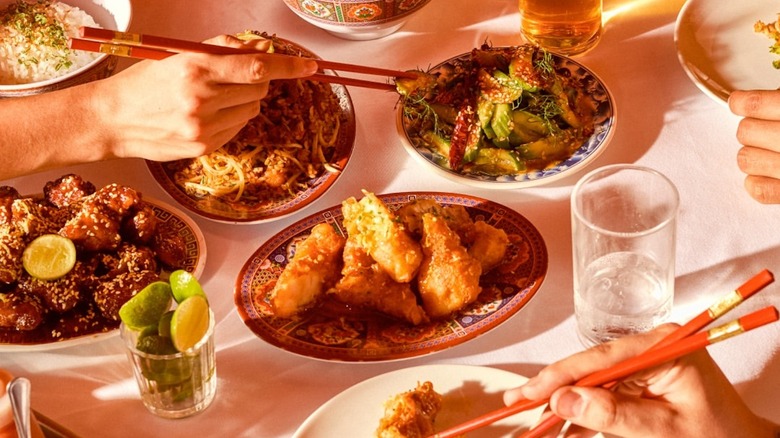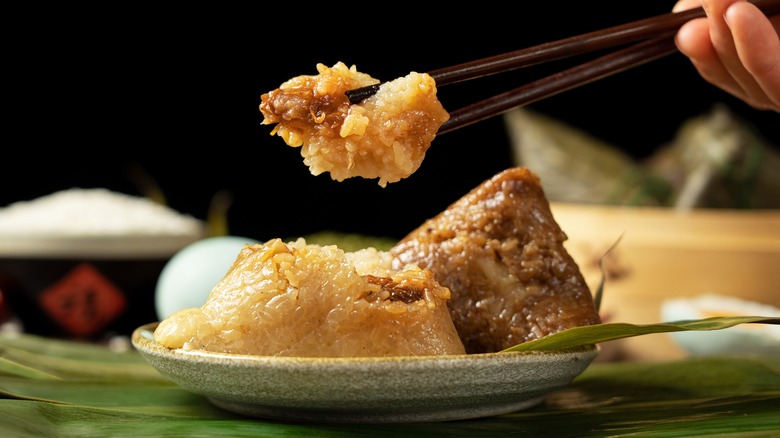The Mexican-Chinese Cuisine You Can't Find In The US
When cultures combine, a certain alchemy happens with the food. Immigrants craving a taste of home use unfamiliar ingredients to recreate a specific memory, and locals who get introduced to new dishes add touches to suit their own tastes. An exchange of flavors, customs, and techniques happens over time, and that is how fusion cuisine is born. The food in Mexicali, Baja California, Mexico is a perfect reflection of this delicious phenomenon, and chef Rick Martinez got to see — or rather, taste — that rich history firsthand.
Martinez fell in love with this Mexican-Chinese cuisine while he was on a 20,000 mile journey across Mexico, researching the diversity of the country's food for his cookbook "Mi Cocina." There, at this region of the United States-Mexico borderlands, he tasted dishes that he described to Food Republic as "incredibly delicious." It was particularly exciting "because it doesn't exist anywhere else in the country, except a few cities along the northern border," as Martinez explained.
Unique, Chinese-influenced styles of tamales, tortillas, stewed meats, condiments, appetizers, and more are now ubiquitous in Mexicali, and you can find them at more than 300 different restaurants in the city. At these establishments, expect to find dishes like rice tamales, tender arrachera steak stir-fried with snap peas, fried rice with chorizo and avocado, and MSG and chile de arbol-seasoned fried shrimp served on top of sauteed bean sprouts.
The history of Chinese immigration in Northern Mexico
This particular Mexican-Chinese culinary tradition began in the late 1800s and early 1900s. Chinese migrants found job opportunities in the mining and railroad industries in California, but were completely barred from immigrating to the United States upon the passing of the Chinese Exclusion Act of 1882. As the closest neighbor, Mexico became a landing place for Chinese immigrants. Some used the strategic location to cross back into the United States, while others found work in the rapidly growing Mexican agricultural industry. Those with entrepreneurial aspirations established businesses like grocery stores, laundromats, and of course, restaurants.
Though Chinese immigrants and their descendants faced prejudiced sentiments, discriminatory policies, forcible displacement, and racist attacks in Mexico too — especially during the economic fall-out of the Great Depression, when work was scarce — those who were not forced to leave made an impact on the region that has lasted to the present day. In fact, Mexicali still has the largest population of Chinese residents in all of Mexico.
Rick Martinez's favorite Mexican-Chinese dishes
Staple dishes from Mexicali are neither Mexican dishes with a Chinese twist nor Chinese plates with a few Mexican touches, but a fully-blended regional cuisine of Mexico all its own. Rick Martinez excitedly described one such preparation to us: "So there is a Chinese tamal, a Chinese-Mexican tamal, and it's rice with carnitas and either red beans, like fermented red beans or garbanzos, and it's wrapped in a triangle shape."
These little parcels likely evolved from the Chinese dish zongzi, particularly the Cantonese style — many of the immigrants to the Baja California region came from Guangzhou, which used to be commonly called Canton by Europeans. Zongzi are traditionally made by stuffing glutinous rice with ingredients such as pork belly, duck, mushrooms, salted and cured duck egg yolks, red beans, scallops, chestnuts, and dried shrimp. The rice is wrapped in bamboo leaves, then steamed or boiled, a cooking process very similar to that of tamales.
Another bite that stuck out to Martinez was a carne asada taco served in a matcha-infused flour tortilla. He hypothesized that the beef was marinated in soy sauce, sesame oil, and fermented bean paste, but he was certain of one thing: "It was so good. Oh my God."



